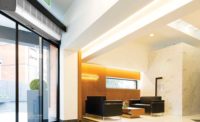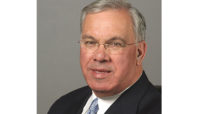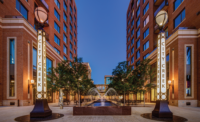When Hooksett, N.H.-headquartered SAM Mechanical— along with a consulting design and mechanical engineer — first began talks with the decision-makers from the state of New Hampshire on how to provide a new state-of-the-art HVAC system for the nearly 100-year-old Tobey Building in Concord, every option was on the table.
The structure, which formerly was a state facility for children with emotional and behavioral issues, was closed since 2009. Three years later, New Hampshire slated $22.5 million for a parking deck at the building, and more importantly, made plans to convert the Tobey Building into the new headquarters for New Hampshire’s Department of Employment Security.
Steve Apriland his partner Robert Camann, the founders of SAM Mechanical, and the mechanical engineer, discussed with the state government about how to tackle this major renovation. The contracting firm brought its nearly 30 years of expertise in the field and design arena to show the state’s leaders their first choice for design might not be the best plan of action.
“The state was very interested in geothermal options,” April recalls. “As time went by it became more and more obvious there were some other potential designs that could be offered.”
April and Camann noted that while geothermal might prove to be a feasible heating and cooling plant alternative, the amount physical room on the site and length of payback were concerns. The mechanical engineer and SAM Mechanical brought another green option to the state for the design of the Tobey Building — off-peak ice production and storage during the night.
“Using this was a way to bring green savings, but to do it another way,” April says.
Off the grid
April believed utilizing off-peak ice production at night would be the ideal design option for the approximately 300,000-sq.-ft. Tobey Building because it is a large institutional building that uses its air-conditioning capabilities year-round to address a data center and internal cooling zones.
“Even on a hot winter day, the building will be cooling by the end of that day,” April states. “A lot of that has to do with the heat gain of the building, the amount of people and equipment in the building, etc.”
At the Tobey Building, a collaborative design effort resulted in a system with sub-grade ice storage combined with a high efficiency air-cooled chiller that “banks” cooling potential during the night hours when electrical and cooling demands are less.
“This off-peak power is sometimes as little as 50 cents on the dollar,” April notes. “In essence, this facility was able to not be part of the grid and be a big draw of power during heavy electrical use periods.”
The chillers at the building make a glycol/water mixture slurry throughout the night that are stored in underground Calmac Icebank tanks. During the work day when other similar buildings would have its chillers working at full capacity, the Tobey Building receives cooling because the mixture cools the water that is pumped throughout a recirculating loop. A Buderus premium efficiency boiler gets the water temperature up to 120-130° F and uses a Bell & Gossett pump to get to the recirculating loop.
“A high demand for cooling on a really hot day was not going to be a part of the process because that was done the night before when the grid is untaxed and the mixture is able to be made,” Camann says. “The ice glycol/water mixutre is made very greenly.”
April and Camann believe the design at the Tobey Building, which they had not created before the Tobey Building, but had understood for many years, became an afterthought when geothermal design and products became prevalent in the market.
“Off-peak ice production design is solid and simple in its approach,” April states. “Geothermal just kind of stole its thunder. That became more popular and way more equipment was manufactured. Also, geothermal was more recognized in green design.”
Up above
The Tobey Building and SAM Mechanical Services — which does the majority of its work in New England, but also has design-build work in other states such as Florida — may have not found such energy-saving success if it were not for the work put in a decade earlier. Engineers, contractors and manufacturers looked for a way to provide a method of air-conditioning delivery similar to baseboard radiant heating.
“About 10 years ago, a bunch of smart people started thinking, ‘Why can’t we do this chilled water and deliver air condition the same way?’” April states. “In theory it would work, but there were obstacles to overcome. There were issues with delivery.”
Chilled beams were the answer and that is what the consulting mechanical engineer and SAM Mechanical Services utilized at the Tobey Building. The chilled beams passively cool the facility (with marginal air induction) by allowing cool air, which naturally drifts down from the ceiling, provide the thermal comfort.
“The chilled beams were the knockout punch for the design to work as well as it does,” Camann states. “The building is cooled 100% passively. That is the outcome the state of New Hampshire and many others were looking for.”
The right fit
In May 2014, New Hampshire’s Department of Employment Security consolidated two-thirds of its statewide workforce for the move from four offices into just the Tobey Building. According to a NEHS press release, the DES helps provide free public employment services through a state network of job and information centers, providing a broad range of assisted and self-directed employment and career-related services and labor market information to all customers, as well as paying unemployment compensation benefits in a timely manner to eligible claimants.
The four-floor Tobey Building has approximately one mile of black-iron pipe per floor, according to April and Camann. Because of the large amount, the SAM Mechanical team felt that utilizing Viega MegaPress fittings would be ideal for the facility. MegaPress connections for black-iron pipe can be made in less than 10 seconds.
“When we started to look at MegaPress, we knew its leak record was very strong,” Camann states. “After we were done, it turned out to be quite better than we expected. We knew we could get a sound system that was put together fast. That was a big part of running the mile of pipe per floor. It was important to go with a system that would not leak and gave me peace of mind that I was helping keep this historical building safe and secure for decades to come.”
April adds: “There are not many systems being built today with modern equipment that are just absolutely puking energy. It happens, but it is not so much engineering mistakes, but concept mistakes. If you have proper and sound concepts, such as meeting codes, the engineering requirements for the occupancy of the building, which the mechanical engineer was crucial in providing, quite often you are going to create a favorable outcome. Especially if you have a good thermal envelope for the building itself.”
The Tobey Building project stayed on an efficient schedule for SAM Mechanical. Design to completed construction took around 15 months, according to April. It also was April’s and SAM Mechanical’s first foray into an off-peak ice production design and construction. But he and his team were confident they could deliver because of their 27 years of knowledge.
“You have to extrapolate information you have acquired over your career,” April says. “When you are a very experienced mechanical firm and you have produced a lot of innovative design-builds, it is not necessarily something you have had to do before. It is something that you need to visualize and understand the parts and pieces to do so. Then plan your work and work your plan, and finally execute a great outcome.”
This article was originally titled “Ice cold” in the April 2016 print edition of PM Engineer.







